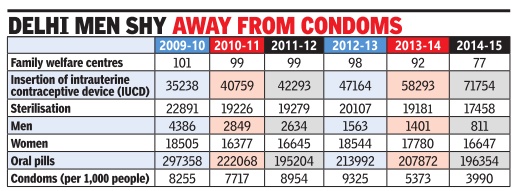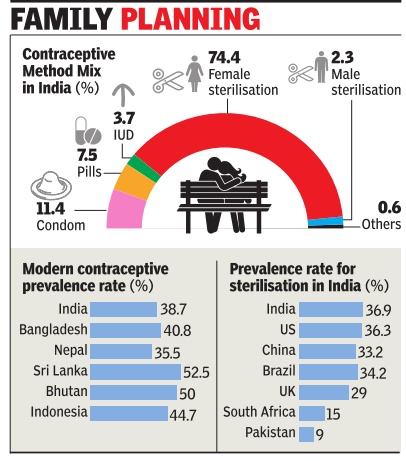Family planning: India
| Line 10: | Line 10: | ||
[[Category:Health |F ]] | [[Category:Health |F ]] | ||
[[Category:Government |F ]] | [[Category:Government |F ]] | ||
| + | [[Category:Bangladesh |F ]] | ||
| + | [[Category:Bhutan |F ]] | ||
| + | [[Category:Nepal |F ]] | ||
| + | [[Category:Sri Lanka |F ]] | ||
[[Category:Society |F ]] | [[Category:Society |F ]] | ||
| Line 40: | Line 44: | ||
“The centres are important for giving information on family planning and offering contraceptive services. Also, we may need to include counselling against sex selection at these centres,“ said Dr Abha Mazumdar, senior gynaecologist at Sir Ganga Ram hospital. | “The centres are important for giving information on family planning and offering contraceptive services. Also, we may need to include counselling against sex selection at these centres,“ said Dr Abha Mazumdar, senior gynaecologist at Sir Ganga Ram hospital. | ||
| + | |||
| + | =2015: high contraceptive prevalence= | ||
| + | [http://epaperbeta.timesofindia.com/Article.aspx?eid=31808&articlexml=Men-stay-off-contraceptives-force-women-into-sterilisation-02012016010014 ''The Times of India''] Jan 02 2016 | ||
| + | [[File: fam.jpg| Modern contraceptive prevalence rate in Bangladesh, Bhutan, India, Nepal, Sri Lanka, 2015; ii) prevalence rate for sterilisation in India, Pakistan and some other countries |frame|500px]] | ||
| + | |||
| + | Sushmi Dey | ||
| + | |||
| + | ''' India's Mix Of Birth-Control Methods Poor ''' | ||
| + | |||
| + | India has been attracting severe criticism from the international community for its poor mix of contraceptive methods. This despite India registering the highest contraceptive prevalence rate for sterilisation at 36.9% as compared to other countries with similar demographics. The US trails India recording a 36.3% rate, China follows at 33.2% and Brazil at 34.2%. | ||
| + | |||
| + | The huge share of female sterilisation coupled with slow pace in adoption of other modern contraceptive methods have raised concerns internationally about women's rights as well as health risks. | ||
| + | |||
| + | Latest data presented by a global partnership Family Planning 2020 (FP2020) showed female sterilisation accounts for 74.4% of the modern contraceptive methods used in India. An additional 3.7% of the same is IUD. As against this, male sterilisation is merely 2.3%, while use of condoms account for 11.4%.Use of pills make just 7.5% of modern methods, whereas injectables and implants are almost absent. | ||
| + | |||
| + | Compare this with 32.1% of female sterilisation, 28.5% injectables, 15% of pills and 10.4% of condoms used as a share of modern contraceptive mix in Sri Lanka. The country has 52.5% modern contraceptive prevalence rate (mCPR).Bhutan, which has 50% mCPR, also accounts for 44.2% of injectables, 10.9% of female sterilisation and 19.3% of male sterilisation as part of the modern method mix. | ||
| + | |||
| + | This also assumes significance in the wake of concerns related to India's rising population and the government's continuous efforts to contain the decadal growth rate Various international agencies including the United Nations, have projected that India will be the most populous nation by 2022. | ||
| + | |||
| + | The government has recently taken steps to improve the cover age and create more awareness about family planning, mainly in rural areas. To ensure a greater thrust on spacing methods, the health ministry has also created specific schemes for Accredited Social Health Activists (ASHAs) to ensure spacing in births. | ||
| + | |||
| + | Besides sterilisation, the Centre is trying to increase the basket of contraceptives and making them available under the national family planning programme. India has introduced injectable contraceptive as part of the scheme. “India must increase the number of users of modern contraceptives so that a greater proportion of all women and girls of reproductive age are served. Offering more types of modern methods in family planning programs will result in higher use,“ says Poonam Muttreja, executive director, Population Foundation of India. | ||
| + | |||
| + | India's population growth rate has declined significantly from 21.54% in 1991-2000 to 17.64% in 2001-11. Government data says, India's total fertility rate has declined from 2.6 in 2008 to 2.3 in 2013 and India is now just 0.2 points away from reaching the replacement level. | ||
| + | |||
| + | So far, 24 states have already achieved replacement level fertility. Nearly 60% of the population resides in states where either replacement fertility is already reached or will soon do. These include West Bengal, Maharashtra, Gujarat and Punjab. | ||
| + | |||
| + | However, 11% more male children are born every year as compared to females, as against a benchmark of 5%, shows UN data. | ||
Revision as of 06:18, 30 January 2016
This is a collection of articles archived for the excellence of their content. |
An arena only for women

Delhi, 2009-15: Women shoulder responsibility
The Times of India, December 10, 2015

DurgeshNandan Jha
Family planning women's burden The national capital is not just battling a skewed sex ratio and women's safety , but also lagging behind in ensuring equality as far as family planning is concerned. Data shows that the onus of family planning predominantly rests with women.They account for 95% of sterilisations conducted at various family welfare centres in the state.
What is even more worrisome is that the number of men seeking sterilisation has gone down in last five years.
In male sterilisation, surgeons cut and seal the tube that carries sperm from the testicles to the penis.
Doctors say this is less painful and complicated compared to female sterilisation that involves cutting, sealing or blocking the fallopian tubes.
Statistics released by Delhi government on Wednesday show that in 2009-10 men accounted for 20% of all sterilisations. It reduced to 14% in 2010-11, 13% in 2011-12, 8% in 2012-13, 7% in 2013-14 and 5% in 201415. “This clearly reflects the bias against women. They are forced for sterilisation and other contraceptive methods while men shirk heir responsibility,“ said Dr Suneeta Mittal, director and head of obstetrics and gynaecology , Fortis Memorial Research Institute, Gurgaon. Apart from sterilisation the public health system provides three other contraceptive services -combined oral contraceptive pills, intrauterine devices (IUCD) and condoms -to people through family welfare centres.
Usage of only IUCD, a device inserted into the uterus to stop pregnancy , has gone up over the last five years.Sterilisation and distribution of oral pills and condoms have gone down. Experts link this to decline in the number of family welfare centres from 101 in 2009 10 to 77 in 2014-15.
Recently , North Delhi Municipal Corporation closed down nearly 20 family welfare centres allegedly due to lack of funds. Other centres run by civic bodies and the state closed due to lack of manpower.
“The centres are important for giving information on family planning and offering contraceptive services. Also, we may need to include counselling against sex selection at these centres,“ said Dr Abha Mazumdar, senior gynaecologist at Sir Ganga Ram hospital.
2015: high contraceptive prevalence
The Times of India Jan 02 2016
Sushmi Dey
India's Mix Of Birth-Control Methods Poor
India has been attracting severe criticism from the international community for its poor mix of contraceptive methods. This despite India registering the highest contraceptive prevalence rate for sterilisation at 36.9% as compared to other countries with similar demographics. The US trails India recording a 36.3% rate, China follows at 33.2% and Brazil at 34.2%.
The huge share of female sterilisation coupled with slow pace in adoption of other modern contraceptive methods have raised concerns internationally about women's rights as well as health risks.
Latest data presented by a global partnership Family Planning 2020 (FP2020) showed female sterilisation accounts for 74.4% of the modern contraceptive methods used in India. An additional 3.7% of the same is IUD. As against this, male sterilisation is merely 2.3%, while use of condoms account for 11.4%.Use of pills make just 7.5% of modern methods, whereas injectables and implants are almost absent.
Compare this with 32.1% of female sterilisation, 28.5% injectables, 15% of pills and 10.4% of condoms used as a share of modern contraceptive mix in Sri Lanka. The country has 52.5% modern contraceptive prevalence rate (mCPR).Bhutan, which has 50% mCPR, also accounts for 44.2% of injectables, 10.9% of female sterilisation and 19.3% of male sterilisation as part of the modern method mix.
This also assumes significance in the wake of concerns related to India's rising population and the government's continuous efforts to contain the decadal growth rate Various international agencies including the United Nations, have projected that India will be the most populous nation by 2022.
The government has recently taken steps to improve the cover age and create more awareness about family planning, mainly in rural areas. To ensure a greater thrust on spacing methods, the health ministry has also created specific schemes for Accredited Social Health Activists (ASHAs) to ensure spacing in births.
Besides sterilisation, the Centre is trying to increase the basket of contraceptives and making them available under the national family planning programme. India has introduced injectable contraceptive as part of the scheme. “India must increase the number of users of modern contraceptives so that a greater proportion of all women and girls of reproductive age are served. Offering more types of modern methods in family planning programs will result in higher use,“ says Poonam Muttreja, executive director, Population Foundation of India.
India's population growth rate has declined significantly from 21.54% in 1991-2000 to 17.64% in 2001-11. Government data says, India's total fertility rate has declined from 2.6 in 2008 to 2.3 in 2013 and India is now just 0.2 points away from reaching the replacement level.
So far, 24 states have already achieved replacement level fertility. Nearly 60% of the population resides in states where either replacement fertility is already reached or will soon do. These include West Bengal, Maharashtra, Gujarat and Punjab.
However, 11% more male children are born every year as compared to females, as against a benchmark of 5%, shows UN data.
